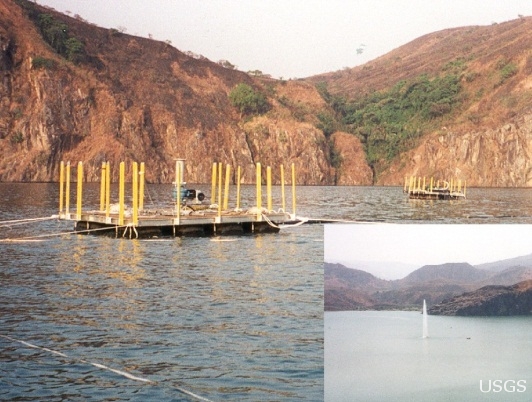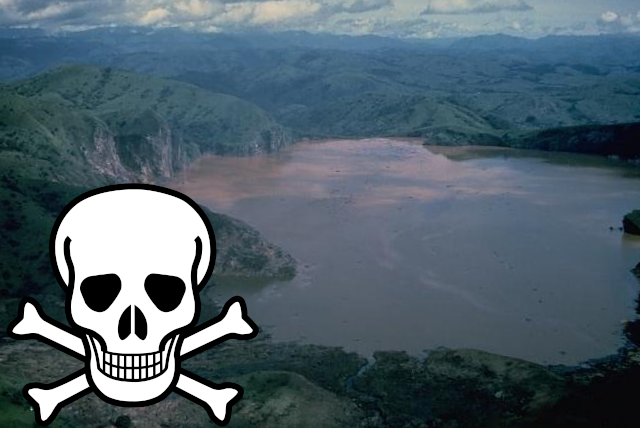On August 21, 1986, death fell over Lake Nyos, Cameroon. The few remaining survivors recount a story of hearing some sort of explosion, walking outside, and seeing whole families dead where they had stood just moments ago. Livestock fields suffered the same fate. Speaking with Smithsonian, one man noted that there were no flies surrounding the dead. They were dead too.
Scientists were relatively quick to diagnose what had happened at Lake Nyos, but only because the same thing had befallen the nearby Lake Monoun just two years earlier. The lake, they declared, had exploded naturally, releasing a huge volume of carbon dioxide into the air and blanketing the local valleys in smothering gas.
Lake Nyos is a crater lake, formed by a volcanic eruption long before humans moved in. Since then, the site of the eruption has filled with water, but it retains its close connection with the moving layers of inner earth below. In those inner layers exists carbon dioxide, which regularly leaks through cracks in the surface. These natural gas leaks are usually small enough that they don’t make a noticeable impact. When they occur underwater, though, the heavy gas has a tendency to collect beneath the surface.
In a shallow lake, collecting CO₂ might be routinely removed through natural processes; gusts of wind can move the water around enough to let it out. In a deeper lake, like Lake Nyos, normal weather patterns aren’t enough, and an equatorial climate means air and temperature movements are even less common. At the time of the lake’s explosion, Atlas Obscura describes five gallons of CO₂ dissolved in each gallon of water. So now we have a potentially-deadly gas gathering beneath the water without an escape path. In other words, a bomb.

Regular weather won’t shake up the carbon dioxide in the lake, but irregular conditions can. On August 21, 1986, something irregular happened. Scientists haven’t agreed on what. Evidence suggests a recent rockslide might be the culprit. Or it might have been unusually cold rain. Whatever it was, it displaced the water and gathering gas enough to produce an explosion over 260 feet tall. Writing for Smithsonian, Kevin Krajick comments on scientific estimates that the ensuing cloud may have contained as much as one billion cubic yards of carbon dioxide.
The CO₂ moved as fast as 45 miles per hour into the surrounding valleys, filling the air with gas. Krajick writes that, at five percent, CO₂ snuffs out candles. At 10%, humans begin to feel dizzy, hyperventilate, and will eventually fall into a coma. Somewhere between 10% and 30%, people drop dead.
According to Atlas Obscura, of the 800 people who lived on the lake, only six survived. The official death toll of the disaster stands at 1,746 people and somewhere around 3,500 animals.
Following the event, the Cameroonian government and military ordered most of the area’s remaining population to leave. Some would not be allowed to return for 30 years. In the interim, the international community of scientists went to work on methods to prevent future explosions in Nyos and lakes like it. Someone suggested bombs. Eventually, they landed on the idea of pipe systems built to funnel carbon dioxide from the lakebed to the air above slowly and without need for massive explosions. The $433,000 for the initial pipe at Nyos was provided by the U.S. Office of Foreign Disaster Assistance.
The preventative measures have been as effective as they are necessary. Testing conducted in the aftermath of the Nyos explosion revealed that it had not completely drained the lake of its pent-up carbon dioxide. Other equatorial lakes, especially deep, crater lakes, are prone to the same problem.

The survivors of the Lake Nyos disaster aren’t likely to forget it any time soon. But something interesting to me is that their ancestors may have found themselves in a similar position; they may have even attempted to warn them. In the Smithsonian piece referred to above (and linked below), Kevin Krajick writes that local traditions warn against settling in the lowlands immediately around a lake, requiring native peoples to instead make their homes in the surrounding highlands. When the disaster hit, those living in the lowlands were almost completely wiped out. The families who had settled on higher ground largely survived.
With time, old legends and traditions faded. Incoming settlers were either ignorant of or indifferent to the bad luck that had settled on the lower-lying land. Further on, some of the high altitude dwellers moved down to join them. Unlike their parents, though, the descendants of those who survived the Lake Nyos disaster won’t have to abide by fears of the lowland coast. A hundred years ago, steering clear of danger zones was the only way to reliably prevent death by lake explosion. Today, there are pipes. And bombs, but those seem counterproductive.
Read/Watch More
- Defusing Africa’s Killer Lakes by Kevin Krajick for Smithsonian Magazine
- How did Lake Nyos suddenly kill 1,700 people? by Susan Nasr for How Stuff Works
- Lake Nyos disaster survivors to return home after 30 years by Al Jazeera
- Lake Nyos Suffocated Over 1,746 People in a Single Night in Atlas Obscura via Slate
